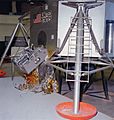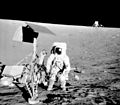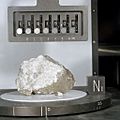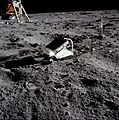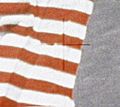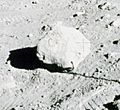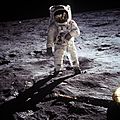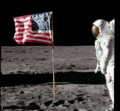Moon landing conspiracy theories facts for kids
The moon landing conspiracy theories are ideas that suggest humans never actually landed on the Moon between 1969 and 1972. Instead, some people believe that NASA faked these historic events. They think that the films and photos of the Apollo program missions were created in a studio.
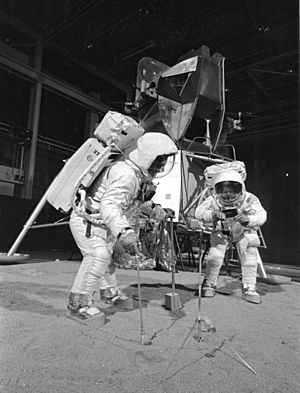
Most scientists and historians agree that the moon landings were real. They consider these conspiracy theories to be untrue. However, on the internet, these ideas can spread easily. This is because anyone can share their thoughts online.
Some groups and people around the world believe these theories. For example, some people in the USA hold these views. Also, some schools in certain countries have taught that the moon landings were faked.
Contents
What Are Moon Landing Conspiracy Theories?
Moon landing conspiracy theories claim that the six Apollo missions that landed on the Moon were not real. These missions took place between 1969 and 1972. The most famous one was Apollo 11, which landed Neil Armstrong and Buzz Aldrin on the Moon in July 1969.
People who believe these theories think that NASA tricked the world. They suggest that all the photos, videos, and samples brought back from the Moon were faked. They often point to small details in images or videos as "proof."
Why Do People Believe These Theories?
There are several reasons why people might believe these theories.
- Distrust of Government: Some people naturally distrust large government organizations like NASA.
- Lack of Scientific Knowledge: It can be hard for some to understand complex science. This makes it easier to believe simpler, but incorrect, explanations.
- Media Influence: Movies, TV shows, and online videos sometimes explore these theories. This can make them seem more believable.
- Looking for Secrets: Some people enjoy the idea of uncovering a big secret or a hidden truth.
What Do Scientists Say?
Scientists, engineers, and historians have carefully studied the evidence. They all agree that the moon landings were real. They say that the conspiracy theories ignore a huge amount of facts.
There is overwhelming evidence that humans did land on the Moon. This evidence comes from many different sources.
Evidence for the Moon Landings
There is a lot of strong evidence that proves the moon landings happened:
- Moon Rocks: Astronauts brought back 382 kilograms (842 pounds) of moon rocks. These rocks have been studied by scientists worldwide. They are very different from Earth rocks. They match rocks found by robotic probes.
- Reflectors on the Moon: The Apollo missions left special mirrors on the Moon. Scientists on Earth can bounce lasers off these mirrors. This proves the equipment is still there.
- Photos from Orbit: Modern spacecraft, like the Lunar Reconnaissance Orbiter, have taken high-resolution photos. These photos clearly show the landing sites. You can see the lunar modules, rover tracks, and even footprints.
- Eyewitnesses: Hundreds of thousands of people worked on the Apollo program. It would be impossible to keep such a huge secret. Many people around the world also tracked the missions.
- Soviet Union Tracking: The Soviet Union was in a space race with the USA. They had the technology to track the Apollo missions. If the landings were faked, they would have exposed it immediately.
Why Are These Theories Popular?
Even with all the evidence, these theories remain popular for some. The internet makes it easy for these ideas to spread. People can find others who share similar beliefs. This creates online communities where these theories are discussed.
It's important to remember that just because an idea is popular online, it doesn't mean it's true. Critical thinking and checking facts from reliable sources are very important.
Related pages
Images for kids
-
Surveyor 3 with Apollo 12 lander in background
-
Lunar Roving Vehicle flown on Apollo 15
-
Apollo 11 landing site – "There the lunar module sits, parked just where it landed 40 years ago, as if it still really were 40 years ago and all the time since merely imaginary." –The New York Times
See also
 In Spanish: Teorías de la conspiración de los alunizajes del Programa Apolo para niños
In Spanish: Teorías de la conspiración de los alunizajes del Programa Apolo para niños


